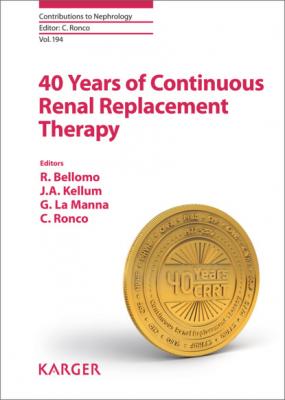ТОП просматриваемых книг сайта:
40 Years of Continuous Renal Replacement Therapy. Группа авторов
Читать онлайн.Название 40 Years of Continuous Renal Replacement Therapy
Год выпуска 0
isbn 9783318063073
Автор произведения Группа авторов
Жанр Медицина
Серия Contributions to Nephrology
Издательство Ingram
41Colì L, Donati G, Cappuccilli ML, Cianciolo G, Comai G, Cuna V, Carretta E, La Manna G, Stefoni S: Role of the hemodialysis vascular access type in inflammation status and monocyte activation. Int J Artif Organs 2011;34:481–488.
42La Manna G, Ghinatti G, Tazzari PL, Alviano F, Ricci F, Capelli I, Cuna V, Todeschini P, Brunocilla E, Pagliaro P, Bonsi L, Stefoni S: Neutrophil gelatinase-associated lipocalin increases HLA-G(+)/FoxP3(+) T-regulatory cell population in an in vitro model of PBMC. PLoS One 2014;9:e89497.
43Camussi G, Ronco C, Montrucchio G, Piccoli G: Role of soluble mediators in sepsis and renal failure. Kidney Int Suppl 1998;66:S3–-S42.
44Uchino S, Bellomo R, Morimatsu H, Morgera S, Schetz M, Tan I, Bouman C, Macedo E, Gibney N, Tolwani A, Straaten HO, Ronco C, Kellum JA: Discontinuation of continuous renal replacement therapy: a post hoc analysis of a prospective multicenter observational study. Crit Care Med 2009;37:2576–2582.
45Cruz DN, Perazella MA, Bellomo R, Corradi V, de Cal M, Kuang D, Ocampo C, Nalesso F, Ronco C: Extracorporeal blood purification therapies for prevention of radiocontrast-induced nephropathy: a systematic review. Am J Kidney Dis 2006;48:361–371.
Claudio Ronco, MD
Department of Nephrology Dialysis and Transplantation International Renal
Research Institute of Vicenza (IRRIV) St. Bortolo Hospital
Viale Rodolfi 37
IT–36100 Vicenza (Italy)
E-Mail [email protected]
This article has already been published in: Contrib Nephrol. Basel, Karger, 2017, vol 189, pp 114–123. Reproduced here with permission from the publisher.
Bellomo R, Kellum JA, La Manna G, Ronco C (eds): 40 Years of Continuous Renal Replacement Therapy.
Contrib Nephrol. Basel, Karger, 2018, vol 194, pp 15–24 (DOI: 10.1159/000485597)
______________________
Evolution of Vascular Access and Anticoagulation
Patrick M. Honorea · Herbert D. Spapenb
aProfessor of Intensive Care Medicine, Deputy Chairman of ICU Department, Director of ICU Research, Centre Hopitalier Universitaire Brugmann, Brussels, and bProfessor of Intensive Care Medicine, Director of Research Unit and ICU, ICU Department, Universitair Ziekenhuis Brussel, Vrije Universiteit Brussel, Brussels, Belgium
______________________
Abstract
Continuous renal replacement therapy (CRRT) is an important and widely used adjuvant treatment in critically ill patients. However, any CRRT protocol can be adhered to only when the technique is correctly installed and functioning properly. Within this context, an appropriate vascular access and a safe and effective circuit anticoagulation method are key requisites. The right internal jugular (RIJ) vein is the preferred route for insertion with the tip of the catheter placed in the right atrium. Both femoral veins offer a valuable alternative access, but catheters must be longer to avoid recirculation and circuit blood flow is lower as compared with that of the RIJ approach. The location of the catheter is not associated with differences in bacterial colonization/infection rate or filter/circuit lifespan. Adequate anticoagulation is imperative to avoid a system “shutdown” due to the early clotting of the filter. For a long time, unfractionated heparin (UFH) was the anticoagulant of choice. UFH is associated with an increased bleeding risk and requires the use of high circuit blood flows. The introduction of regional citrate anticoagulation (RCA) created a paradigm change in CRRT anticoagulation. RCA can be applied safely in patients with increased bleeding risk and may enhance filter and circuit survival as compared with UFH. RCA requires close monitoring for potentially serious metabolic side effects. Future perspectives include improved catheter technology and development of novel citrate solutions with less severe metabolic impact.
© 2018 S. Karger AG, Basel
Vascular Access
Vascular Access Site and Catheter Positioning
A well-functioning vascular access is imperative to avoid premature failure of the continuous renal replacement therapy (CRRT) circuit [1–3]. According to Poisseuille’s law, flow through a catheter is related to the fourth power of its radius and inversely related to its length. Thus, the ideal catheter is short and has a large (13–14 Fr) diameter [1–3]. Observational studies showed more malfunctioning and shorter survival for femoral than for jugular dialysis catheters and for left-sided compared to right-sided jugular catheters [3]. A large randomized French multicenter trial did not find a difference in catheter dysfunction between the jugular and femoral approach [4]. However, when right and left jugular catheters were analyzed separately, a trend was observed toward more dysfunction with the femoral than with the right jugular route as well as significantly more dysfunction with the left jugular compared to the femoral access [4]. Based on these observations and additional data from several large studies [4, 5], the Kidney Diseases Improving Global Outcomes (KDIGO) guidelines [6] recommend that the right internal jugular (RIJ) vein should be preferred to obtain vascular access for CRRT. Both femoral veins remain a valuable alternative. Subclavian access is the least advised method because it involves an enhanced risk of kinking and stenosis (Fig. 1). It is self-evident that large-bore catheters will permit better blood flow. In addition, the tip of the catheter should be located in a large vein to assure more adequate blood flow and reduce the risk of recirculation [1–3]. Femoral catheters measuring at least 30 cm are recommended, since catheters of less than 20 cm length cause 3 times more recirculation [1–3]. Insertion of longer soft silicone short-term dialysis catheters in the right atrium proved to be safe and enabled to enhance CRRT life span and to optimize daily delivered CRRT dialysis dose compared with the use of shorter catheters placed in the superior vena cava [5, 7]. Atrial placement of soft-tipped CRRT catheters did not induce more atrial arrhythmia [5, 7]. Accordingly, the KDIGO guidelines recommend placing the tip in the right atrium [6]. RIJ and femoral access are not associated with differences in filter lifespan (FLS) [4,

